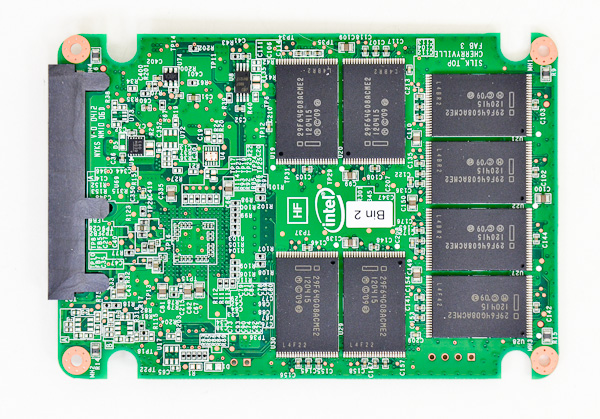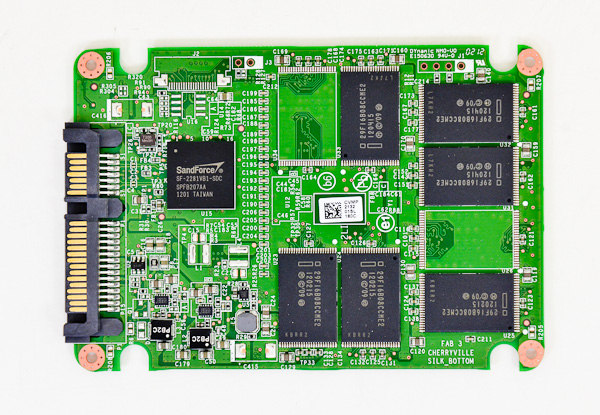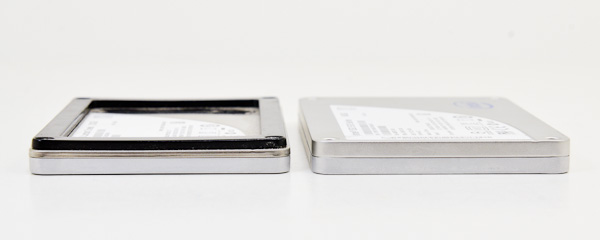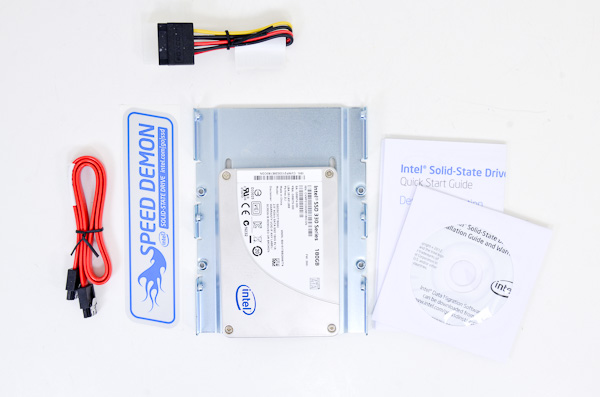The Intel SSD 330 Review (60GB, 120GB, 180GB)
by Anand Lal Shimpi on August 1, 2012 12:01 AM ESTThe Drives and Internal Architecture
The SF-2281 controller features eight NAND channels, although it can pipeline multiple requests on each channel. The 60GB and 120GB drives both feature eight NAND packages with one 8GB die and two 8GB die per package, respectively. That works out to be 64GiB of NAND on the 60GB drive, and 128GiB of NAND on the 120GB drive. RAISE is disabled on both of these drives, all spare area is dedicated for the replacement of bad blocks as well as garbage collection/block recycling.

Intel's SSD 330 60GB, all NAND appears on one side of the PCB
The 180GB drive on the other hand uses twelve NAND packages, with two 8GB 25nm MLC die per package. The math works out to be 192GiB of NAND. SandForce's redundant NAND technology (RAISE) is enabled on the 180GB drive, so the extra spare area is divided between NAND failure coverage as well as traditional garbage collection/bad block replacement. Note the non-multiple-of-eight NAND configuration poses a bit of a challenge for extracting peak performance out of the drive, however it's still able to deliver a tangible advantage over the 120GB version. It's possible that Intel still routes all 8 channels to NAND die and simply sacrifices pipelining of requests on some of the channels.

Intel's 180GB SSD 330 features twelve NAND packages (6 on each side)
In the case of all of the Intel SSD 330 models, the SF-2281 controller is cooled by a thermal pad that helps dissipate heat across the SSD's metal chassis. All 330s are 9.5mm thick without any external removable spacer, which sets these drives apart from most Intel SSDs. Strangely enough, the plastic spacer that's normally on the outside of the drive is actually located on the inside of the 330, although it's not actually responsible for the thicker form factor. I'm not sure why, but it's in there.

Typical 9.5mm Intel SSD (left) vs. 9.5mm Intel SSD 330 (right)
The Bundle
The standard 330 bundle comes with a molex to SATA power adapter, a SATA cable, a 2.5" to 3.5" drive sled and a link to download Intel's Data Migration Software (powered by Acronis).
As the 330 isn't targeted at OEMs, I'm not sure if we'll see standalone drives sold without the bundle. As of now this is the only way to get the 330.












64 Comments
View All Comments
Kristian Vättö - Thursday, August 2, 2012 - link
Check back tomorrow ;-)antef - Wednesday, August 1, 2012 - link
Buy buy buy! Even less than what Anand's chart show. What a deal.bim27142 - Wednesday, August 1, 2012 - link
I am really torn between Samsung 830 128GB and Intel 330 180GB...I am just a typical user and a casual gamer... I've read good reviews about Samsung's performance at since it's not Sandforce based...
Capacity-wise, I really find the Intel 180GB just right enough for me... So I am really torn which one is better for my case... :(
mailrachit - Monday, August 13, 2012 - link
As 'a typical user and casual gamer' myself I was asking the same question Samsung 830 128 GB or Intel 330 180 GB just two months ago when I was making a new ivy bridge desktop rig.I went with Intel 330 180 GB and I must say that I am quite happy with my decision.
The performance is stellar. I trust Intel for reliability and God knows I need the extra space (180 GB - 128 GB).
Look for deals and you can get the Intel one for real cheap (I got it for $110).
angelsmaster - Tuesday, September 4, 2012 - link
hi, i just also bought the 330 series but now, its 240 gb.. did you update the firmware,, cause i cant seem to find one for th 240gb. i know its the same as 180gb model. but i can't seem to make the link work. btw. iam using macbook pro 15" 2011. thank...SewerSoldier - Thursday, August 2, 2012 - link
Hi,I'm currently looking at buying a 120/128GB system/application SSD for use beside a 1TB HDD for media.
I'm deciding between Samsung 830 Series and Intel 330. However in my country the samsung costs 130€ and the intel 112€.
My question is if I'm right in assuming that Intel 330 is the better choice since the better performance of the samsung with incompressible data isn't really important for a system/application drive?
softdrinkviking - Friday, August 3, 2012 - link
disappointed that intel hasn't come back with a new controller of their own. I own and love a 34nm intel drive, and I love how reliable it has been.it seems like intel can really put out good stuff when they put enough R&D into it, but I am not sure about their track record when working with other companies on tech. (like sandforce)
Per Hansson - Saturday, August 4, 2012 - link
Well honestly there have been reports of the "8MB bug" happening even with the latest firmware on the Intel 320 drive so I would not be so sure about that...http://communities.intel.com/thread/24339
http://communities.intel.com/message/162330
http://communities.intel.com/message/161880
softdrinkviking - Saturday, August 4, 2012 - link
Oh yeah, I forgot about that whole fiasco. Still, there is something I don't like about relying on data compression technology to speed up a drive. The potential for catastrophic data loss seems to be higher if you are dealing with multiple levels of logic abstraction. For similar reasons, I never used those drive doubler technologies that were popular before traditional HDDs became so big.Thinking about it from a data recovery point of view, how would this effect the difficulty and cost of recovering data from a drive?
I know the whole recovery process would be totally different from a HDD, but it still could be a consideration.
booomups - Thursday, August 30, 2012 - link
i really wonder about this, since it seems strange if intel says on some drives it does and in others it doesn make sense. in the review it says its enabled for the 180gb version, and not for the 120gb version. how certain is that even in newer drives revisions?and... intel doesnt mention e aes encryption for the 330 drives, but it is a big point for the 520 drives.
any details on that, ita the same chip after all.